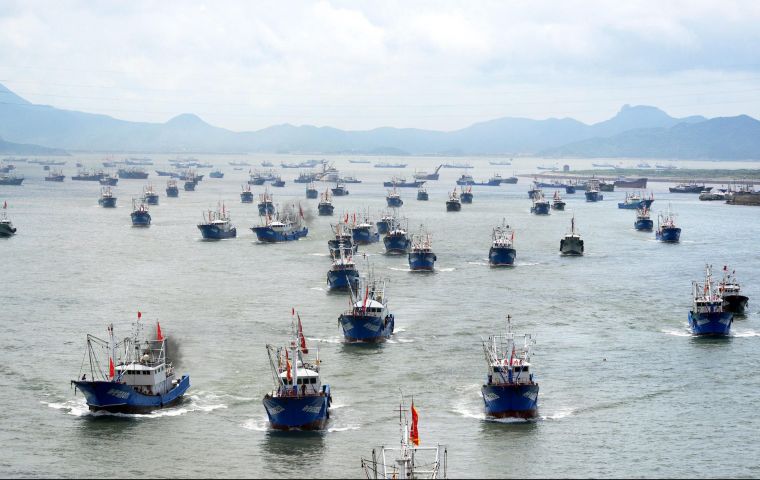MercoPress. South Atlantic News Agency
China's fisheries policy changing? Diverting fuel subsidies from vessels to good WTO fishing practices
 China has been paying fuel subsidies to fishing vessels, based on size and time spent at sea, since 2006, expanding fishing capacity, overfishing and other sins.
China has been paying fuel subsidies to fishing vessels, based on size and time spent at sea, since 2006, expanding fishing capacity, overfishing and other sins. China is growing up to its international commitments: two coastal provinces following instructions from the Ministry of Agriculture and Rural Affairs have started to award “fishery stewardship subsidies” to its vessels depending on how they implement measures such as catch volumes, respecting opening and closure of seasons, during the previous year.
First it was Shandong who announced a similar system of compensations for good behavior late last year, and now Fujian has joined paying out the so called, “fishery stewardship subsidies” to vessels registered within its borders.
Although the policy document instructions from Beijing have not been made public, it is believed they respond to the current discussions in the World Trade Organization to put an end to harmful fishing subsidies globally, of which Chinese fishing vessels have been among top of the list for many years. In effect China has been paying fuel subsidies to fishing vessels, based on size and time spent at sea, since 2006, expanding fishing capacity, overfishing and other sins.
So, in 2016–2020, China started to cut those subsidies, and diverted payments to fishing vessels that reduced catches or changed activity to encourage more sustainable fishing and aquaculture.
Likewise in mid-February, the Ministry set a target for annual distant-water fishing (DWF) catches, of 2.3 million tons, unchanged from the 2016–2020 period. Alongside controlling vessel numbers and keeping capacity stable, China plans to improve oversight of DWF vessels, improve implementation of international fishery agreements, and encourage upgrades for “high-quality” growth.
According to the policy document, this includes “promoting a comprehensive system of DWF fishing oversight including vessel positioning, electronic fishing logs, remote video monitoring, supervision of trans-shipments and product tracing.”
During 2016–2020, China built up a system for assessing how well vessels conform to international fishery agreements. It also put into effect a voluntary closed season in two patches of the high seas and sent observers to monitor high seas trans-shipments.
In the coming five years, China is set to continue to bolster its capabilities to regulate and study DWF. In particular, it will follow up on the China squid index by developing a China tuna index, to help guide pricing.




Top Comments
Disclaimer & comment rulesCommenting for this story is now closed.
If you have a Facebook account, become a fan and comment on our Facebook Page!